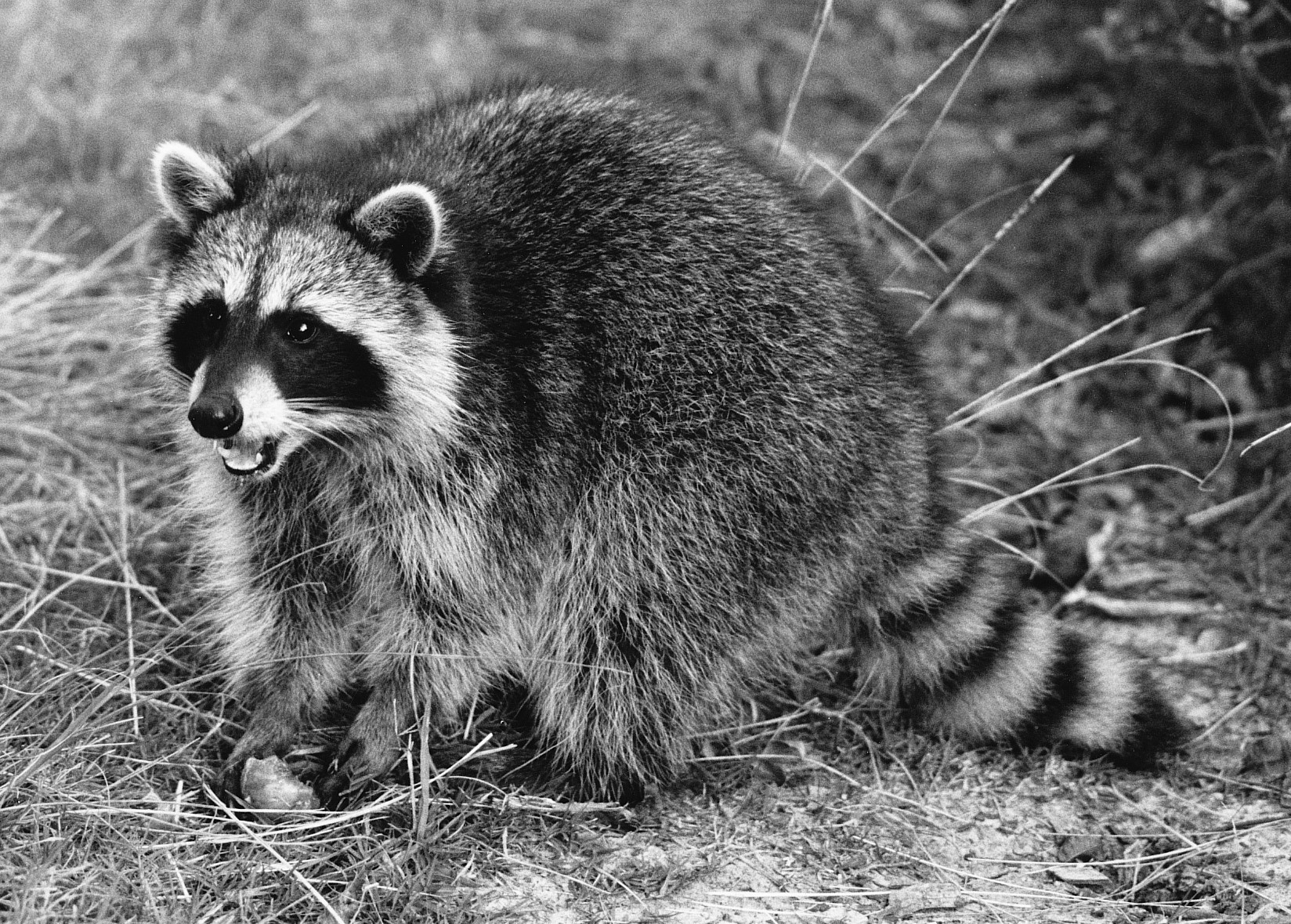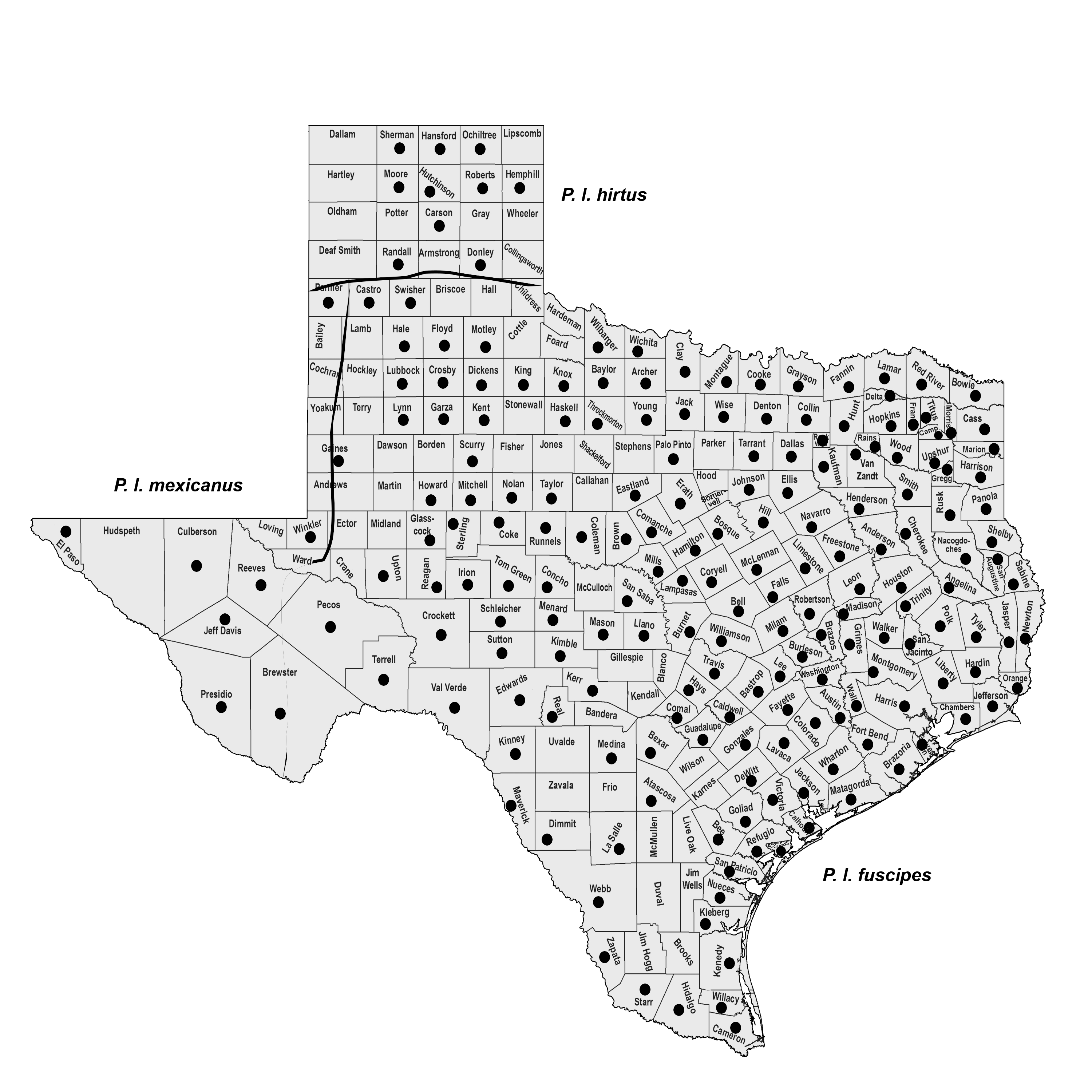NORTHERN RACCOON
Procyon lotor (Linnaeus 1758)
Order Carnivora : Family Procyonidae
DESCRIPTION. A robust, medium-sized carnivore with distinctive blackish facial mask outlined with white and with alternating black and buff (or whitish) rings on the bushy tail; tip of tail black; general color of upperparts grayish, suffused with orange and heavily sprinkled with blackish buff; top of head mixed gray and brownish black, giving a grizzled effect; throat patch brownish black; rest of underparts brownish, thinly overlaid with light orange buff; limbs similar to underparts, but becoming whitish on feet except for dusky marking near heels; the complete hind foot touches the ground when the animal walks; five toes on each foot, claws nonretractile; soles naked; pelage coarse, long, and full. Young are similar to adults, but fur woolly. Molar teeth flat-crowned and adapted for crushing, not for cutting as in dogs and cats. Dental formula: I 3/3, C 1/1, Pm 4/4, M 2/2 × 2 = 40. External measurements of an adult male: total length, 880 mm; tail, 265 mm; hind foot, 125 mm; of a female, 834-243-123 mm. Weight, 4–13 kg.

DISTRIBUTION. Raccoons are widely distributed across southern Canada, most of the United States (except parts of the Rocky Mountains and the arid Southwest), and southward through Mexico. They occur statewide in Texas.

SUBSPECIES. Procyon l. hirtus in the Panhandle north of the Canadian River, P. l. mexicanus in the western part of the Trans-Pecos, and P. l fuscipes throughout the remainder of the state.
HABITS. Northern raccoons occur statewide in all vegetative regions of Texas, but they are seldom found far from water, which has an important influence on their distribution. They prefer hardwood-timbered habitats and are especially abundant in the eastern half of the state along the larger streams where wide floodplains and adjacent sloping uplands support mature stands of hardwood timber. They occupy a variety of other habitats, including bottomland swamps, marshes, land around lakes or ponds surrounded by narrow stands of trees, farmlands (especially those with corn or milo fields), and heavily wooded residential areas in cities. They are abundant in western Texas, where they occur along permanent streams as well as in the driest desert places where humans have brought water by windmills, pumps, or surface tanks. Raccoons also inhabit the montane regions of the Trans-Pecos where sources of water are associated with wooded areas.
Raccoons live in dens located primarily in trees or rock ledges. The absence, however, of suitable natural den sites does not seem to limit their distribution, as they commonly use barns, houses, and other available buildings. Raccoons also are known to share the same ground dens used by striped skunks and opossums, although not necessarily at the same time.
Raccoons are nocturnal and typically spend the day in their dens. Raccoons do not hibernate, but during cold winter periods they may remain in the den for several days and live off their body-fat reserves. Raccoon movement patterns vary seasonally and with a variety of conditions, such as habitat type, population density, and reproductive condition. Adults generally are solitary, although they often associate in groups of more than two individuals. Associations of adult males and females are largely restricted to the breeding season.
Raccoons eat a wide range of both plant and animal food. They are selective when food is abundant but eat whatever is available when it is scarce. Plant food, particularly acorns and fruits, makes up over 50% of the annual diet. Insects, especially grasshoppers, are second in importance, followed in descending order by mammals (cottontails and small rodents), invertebrates other than insects (crayfish and crabs), cold-blooded vertebrates (snakes and frogs), and birds (cardinals, blackbirds, sparrows, and meadowlarks). In West Texas, raccoons have adapted to feeding at artificial deer feeders, leading to local population increases in some areas.
The mating season begins in February and continues through August. A higher percentage of females mate in March, and most of the young are born in April or May. The gestation period is about 63 days and litter size varies from two to four (with an average of 2.8).
Young raccoons (kits) are well haired at birth and have dark skin with no rings on the tail; the eyes and ears are closed. The eyes open between the 18th and 23rd day. Females have the prominent or sole role in caring for the young. Weaning of the young occurs between the ages of 7 and 12 weeks. Families den together during the winter, and most young do not disperse from their natal area until the year after their birth.
Most raccoons in the wild live <5 years. Their major predator is humans, particularly hunters and trappers and occasionally bobcats, foxes, coyotes, and owls. Other factors causing mortality include food shortages, disease, parasitism, physiological stress arising from high population densities, and motorized vehicles.
Raccoons carry a variety of diseases that can be communicated to humans, including leptospirosis, rabies, Chagas disease, and tularemia. In the southern United States, both leptospirosis and tularemia have their largest reservoirs in raccoon populations, and the pathogens causing these diseases are transmissible through direct contact with raccoons or by water contaminated with raccoon urine or feces.
Raccoons are the most economically important furbearer in Texas. Most of the catch is in the eastern half of the state. In 2001–2002, trappers reported capturing 35,943 raccoons; however, fur buyer reports indicate declining purchases in recent years. Despite declining demand and prices for furs, the raccoon remains among the most valuable fur-bearing species in the state because the total harvest far exceeds that of any other species.
POPULATION STATUS. Common. This is one of the most common carnivores in Texas. Across much of the state, northern raccoon populations have increased dramatically in the last several years. One hypothesis is that corn from deer feeders has provided raccoons with a supplemental food source. This additional protein may enable raccoons to better survive the winter months.
CONSERVATION STATUS. The IUCN lists the northern raccoon as a species of least concern, and it does not appear on the federal or state lists of concerned species. It has adapted well to human conditions and the species is in good shape.
From The Mammals of Texas, Seventh Edition by David J. Schmidly and Robert D. Bradley, copyright © 1994, 2004, 2016. Courtesy of the University of Texas Press.
Natural Science Research Laboratory
-
Address
Museum of Texas Tech University, 3301 4th street, Lubbock, TX 79409 -
Phone
806.742.2486 -
Email
nsrl.museum@ttu.edu

